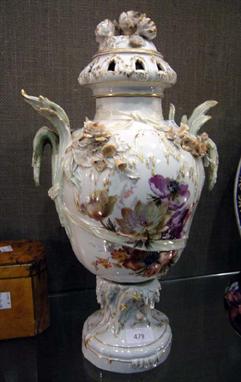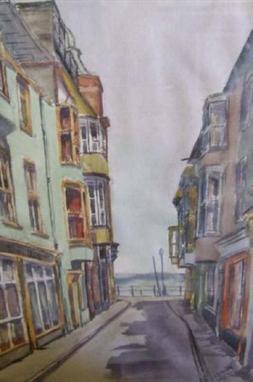We found 297893 price guide item(s) matching your search
There are 297893 lots that match your search criteria. Subscribe now to get instant access to the full price guide service.
Click here to subscribe- List
- Grid
-
297893 item(s)/page
A Victorian three piece tea service R&H Sheffield 1849, comprising teapot, twin handled sugar bowl and milk jug, the tapered bodies with embossed floral and scroll rococco design with scroll handles and raised on bracket feet with scroll garlands between (3) teapot 16cm high, combined weight 43oz
An 18ct gold hunter cased pocket watch, the white enamel dial with black Roman numerals and hands and subsidiary seconds dial with Arabic numerals, with keyless wound lever movement, cuvette inscribed 25TH MAY 1902 FROM M.L.M., case monogrammed, contained in a fitted box, box and movement signed R. STEWART ... GLASGOW Diameter 4.7cm
A pair of Sheffield plated wine coasters with scalloped everted rim with fruiting vine decoration with open trialing branch rim, with turned wooden bases with circular boss to centre; together with two plated coaster of similar design (4) From "THE ESTATE OF THE LATE MRS J R F (COOKIE) MATHESON"
A modern silver mounted ice bucket by Asprey & Company Birmingham 1912, the tapered glass bucket with incised girdle, simple collar mounted with swing handle; together with a plated example with fruiting vine decoration, with branch formed swing handle and associated tongs (3) Asprey example 14cm high (excluding handle) From "THE ESTATE OF THE LATE MRS J R F (COOKIE) MATHESON"
A small wine ewer R Stewart Glasgow 1912, the tapered plain boy with large rim and V neck spout with bacchus mask, the hinged domed lid with scroll thumbpiece with Queen Ann shilling inset to center, C-scroll handle with ivory insulators; together with a Birmingham 1912 teapot, of baluster rectangular outline with canted corners, scroll spout and angular wooden handle, wit domed cover with carved finial (2) Glasgow ewer 213cm high, 11oz, teapot 13.5cm high 18oz
A Victorian presentation snuff box John Lily, London 1839, bright cut decoration of scrolled foliage, presentation inscription to interior 10cm Engraved to the interior, "Prize of five pounds by the East Norfolk Agricultural Society....... Norwich July 1846.......R Garrette, Leiston Works...... Kentish Drill........ purpose of agriculture"
A pair of Victorian comports by Charles S Harris, London 1888, the shaped oval outline baskets with embossed and chased floral decoration with pierced details, on slender short stem with spreading oval foot with reticulated and pierced floral decoration (2) 19cm wide each 8oz From "THE ESTATE OF THE LATE MRS J R F (COOKIE) MATHESON"
A good collection of items a large sugar caster by Walker and Hall Sheffield 1893, the baluster body with semi spiralled fluter lower section, the domed pull off cover with embossed scroll decoration and pierced detail; a pair of modern capstan pepper grinders; a pair of open salts London circa 1770, of oval outline with pierced gallery sides with reeded rim, on four claw and ball feet; a modern drum mustard pot with pierced scroll sides and bombe shaped tea caddy with embossed decoration (7) caster 21cm high From "THE ESTATE OF THE LATE MRS J R F (COOKIE) MATHESON"
A Victorian South Africa medal with four clasps for Johannesburg, Paardeburg, Modder River and Belmont; an Edward VII South Africa medal with clasps for South Africa 1901 and 1902 and three other 1914-18 war medals presented to 28528 GNR R Connelly RFA, 28528 GNR R J Connolly 18th Batt RFA and DVR R Connolly FA; together with other civilian medals and a pair of old Police handcuffs
Spot-On: blue L.151 Police Public Call Box, road signs includng National Speed Limit, two R.128/1 30 MPH Speed Limit, Railway Crossing (No Gates), Road Narrows, two Z-Bends at 3/4 mile, Halt at Major Road Ahead and Roundabout, (four with detachable bases), empty 259 Consul Classic box, four check-lists and two club-slips (17)
A late Victorian oak and brass bound library cabinet, the interior fitted with an arrangement of drawers and pigeon holes, printed portraits of Captain Henry James and bearing a brass plaque inscribed 'Bureau of Sir Henry James R E, 1862', and each door mounted with a monogram, with stylised hinges and drawers below, 42 1/2" wide.
On behalf of the beneficiaries of a Cheltenham estate The following lots were originally owned by Moses Nightingale, who was a Sussex corn merchant and founder of the Hazeldene Orchestra. He was an avid art collector and particularly fond of the work of Henry Herbert La Thangue. By 1919, amongst the vast collection of works that covered the walls of his home at Hazeldene, at least twenty three works can be counted by La Thangue. Further accounts suggest that he acquired many more paintings by this artist after this date. HENRY HERBERT LA THANGUE R.A. (BRITISH, 1859-1929) Provencal Oaks, Bormes, 1913, signed 'H. H. LATHANGUE' lower right, oil on canvas, 21 ½" x 23 ½" (see illustration) Provenance: Purchased by Moses Nightingale Esq. (possibly from the Leicester Galleries, London, 1914); thence by descent Exhibited: London, Leicester Galleries, Exhibition of Paintings by H. H. La Thangue, R.A., April 1914, no. 9 Brighton, City Art Gallery and Museum, Memorial Exhibition of Works by the Late H. H. La Thangue R. A., September 1930, no. 21 Literature: Anon, Watercolours and Oils at Hazeldene, Crawley, Sussex, 1919, no. 105, as Provencal Oaks, Bormes, 1913 La Thangue established a studio at Bormes, a village eight miles from Hyères, during the Edwardian years, just before its 'semi-Moorish streets … mellow with age' began to attract itinerant artists. The New Zealand painter, Sydney Lough Thompson, who visited him in 1915 indicates that he was well established in the village prior to the Great War. Thompson appears to have followed in La Thangue's footsteps, painting in Bormes, St Jeannet and Grasse in the 1920s, one of many artists attracted to the region. A travel writer of the twenties noted that it had 'found favour in the sight of many painters who wish to pursue their art beneath the azure skies of the midi, far from the grey winter of Paris or Brittany' (Capt. Leslie Richardson, Things Seen on the Riviera, 1927, p. 25). Known since 1968 as Bormes-les-Mimosas, the town lies at one end of the 'Mimosa Road' which stretches up the coast to Grasse, centre of French perfume production. As is clear from La Thangue's Royal Academy Diploma picture, collecting flowers for perfume became one of the painter's most important themes (McConkey, A Painter's Harvest, 1978, Oldham Art Gallery, no. 31). Exploring cart tracks to discover neglected hillside gardens became his daily routine in the years preceding his solo exhibition of 1914 and many landscapes resulted. Provencal Oaks, Bormes, included in the Leicester Galleries exhibition in 1914, shows the small evergreen, shallow-rooted Cork or Kermes oaks native to the area (Comerfield Casey, Riviera Nature Notes, 1903, [2004 ed.], p. 47). Other Nightingale acquisitions such as A Provencal Sea, Bormes, shown at the Royal Academy in 1918, and two further works entitled Provencal Landscape, Bormes, show trees of a similar variety. One of these, identical in size to the present work and painted from a slightly more elevated position overlooking the bay, may have been intended as a companion-piece, A Provencal Landscape, Bormes, c. 1913 (sold Christie's 19 June 1997) (fig 1). Commenting on his work in 1905, the critic of The Academy noted that while 'he delights in the brilliant lights and reflections of southern climes…Every touch appears to have been put on with a heavily loaded spatula and…he is scrupulous to give the conflicting colours of reflection…' The effect gave La Thangue's landscapes a characteristically granular quality which, sometimes reminding the viewer of Monet's work, is quite unique. In common with Monet, La Thangue also appears to have been fascinated by the changing light at different times of the day, although he appears not to have painted these phases from precisely the same angles.
HENRY HERBERT LA THANGUE R.A. (BRITISH, 1859-1929) A Sussex Hayfield at Graffham, 1912, signed 'H. H. LATHANGUE' lower left, oil on canvas, 25 ½" x 29 ¼" (see illustration) Provenance: Purchased by Moses Nightingale Esq. (possibly from the Leicester Galleries, London, 1914); thence by descent Exhibited: London, Leicester Galleries, Exhibition of Pictures by H. H. La Thangue, R.A., April 1914, no. 41 Brighton, City Art Gallery and Museum, Memorial Exhibition of Works by the Late H. H. La Thangue R. A., September 1930, no. 24 Literature: Walter Sickert, 'Mr La Thangue's Paintings', The New Age, vol XV, no. 1, 7 May 1914, p. 18 Anon, Watercolours and Oils at Hazeldene, Crawley, Sussex, 1919, no. 108 as Sussex Hayfield at Graffham, Sussex, 1912 Osbert Sitwell ed., A Free House! Being the Writings of Walter Richard Sickert, 1947 (MacMillan), p. 272 Anna Gruetzner Robins, Walter Sickert: The Complete Writings on Art, 2002, (Oxford University Press), pp. 364-365 While he spent his winters during the Edwardian years in Provence and the regions of northern Italy, La Thangue returned to England to work in the fields around his home at Graffham in Sussex between hay cutting in June and the grain and fruit harvests of September. He had moved the relatively short distance from Bosham to Graffham in 1898 because the new location offered a greater range of possibilities, and immediately he began a series of striking figure pieces with Love in the Harvest Field, shown at the Royal Academy in 1899 (unlocated). La Thangue first moved to Sussex in 1890, on the advice of James Charles, who also lived at Bosham. Charles, a figure and landscape painter from Warrington in Cheshire, shared La Thangue's early Bradford patrons. Both artists looked to France for inspiration and both were influenced by work of Bastien-Lepage and Léon Lhermitte, also popular with West Yorkshire collectors. Lhermitte in particular set out to document la vie rustique and by 1900, was in the midst of a long series of harvest scenes that La Thangue would have been familiar with (fig 1). Known primarily as a figure painter, La Thangue closely observed the freer and more informal style in Charles' harvest scenes around the turn of the century. Suspicious of the picturesque seductions of his more conventional contemporaries like Alfred East and David Murray, he slowly developed his own approach to landscape painting after he moved away from Bosham. By the time of his solo exhibition at the Leicester Galleries in 1914, this process was complete and the rich texture of works like A Sussex Hayfield at Graffham separates it from the looser paint structures of Charles's Windy Weather, (fig 2). Where most landscape painters, including Charles and Lhermitte, favoured open country, La Thangue used foreground trees to help place his figure and take the eye successfully to the hay-cart in the middle distance. Moses Nightingale, a Sussex corn merchant, having purchased two pictures, On Lavington Down and A Ligurian Mill Race, shown at the Royal Academy in 1901 and 1905 respectively, returned to collecting around 1914. La Thangue, who by then had secured full membership of the Royal Academy, was staging a solo exhibition at the Leicester Galleries. An earlier generation of Nightingales, hailing from Rotherham, had donated a substantial collection to the town, including an early Landscape Study by the artist. However, Moses Nightingale was to become La Thangue's most important patron, listing twenty-three works in a catalogue of the watercolours and oils at Hazeldene, his house in Crawley. Following the painter's death, Nightingale lent generously to his memorial exhibition at Brighton Art Gallery and the Royal Academy 'Late Members' exhibition in 1933. Thereafter he split his collection between members of his family. Coming three and half years after Roger Fry's celebrated Manet and the Post-Impressionists exhibition, and coinciding with the scandalous exposure of the Vorticists and the Italian Futurists, La Thangue's Leicester Gallery landscapes must have looked traditional, even by Camden Town School standards. Despite their compositional strength, his landscapes were greeted with faint praise in The Times (20 April 1914, p. 12) and attacked by Laurence Housman in The Manchester Guardian (18 April 1914, p. 10). While reservations were also expressed by The Athenaeum and The Connoisseur, The Academy praised La Thangue's honesty and the 'daring' of his 'handling and mastery of colour' (McConkey, 1978, p. 13). It was Walter Sickert however, who cited the present work in a glowing review that swept away all reference to the current turmoil in contemporary art. What would have appealed to Sickert in the present work? In his review, Sickert referred to Monet and Cezanne, now familiar to British audiences. La Thangue was not their follower, but he did possess their dedication to developing 'a series of colour relations…grading from russet towards ruby' on which he was able to 'build…a series of beautiful and interesting sensations of nature'. This was his unique discovery, and it did not depend on clever quotation from 'the gamut of Monet'.
HENRY HERBERT LA THANGUE R.A. (BRITISH, 1859-1929) An Alpine Village, St. Jeannet, France, signed 'H. H. LATHANGUE' lower left, oil on canvas, 21" x 24" (see illustration) Provenance: Purchased by Moses Nightingale Esq., (possibly from the Leicester Galleries, London, 1914); thence by descent Exhibited: London, Leicester Galleries, Exhibition of Paintings by H. H. La Thangue, R.A., April 1914, no. 22 Brighton, City Art Gallery and Museum, Memorial Exhibition of Works by the Late H. H. La Thangue R. A., September 1930, no. 27 Literature: Walter Sickert, 'Mr La Thangue's Paintings', The New Age, vol XV, no. 1, 7 May 1914, p.18 Anon, Watercolours and Oils at Hazeldene, Crawley, Sussex, 1919, no. 121 as An Alpine Village, St. Jeannett (sic), France, 1912 Osbert Sitwell ed., A Free House! Being the Writings of Walter Richard Sickert, 1947 (MacMillan), p. 272 Anna Gruetzner Robins, Walter Sickert: The Complete Writings on Art, 2002, (Oxford University Press), pp. 364-365 La Thangue was captivated by the picturesque hill villages of Provence and Liguria. St Jeannet, between Vence and Nice was a particular favourite, being painted from a number of vantage points. Nightingale owned at least six works painted in and around the village, two representing rose gardens. In concept, An Alpine Village reiterates La Thangue's earlier December in Provence, (fig 1, unlocated) shown at the Royal Academy in 1901. Both works portray groves lying at the foot of hillside villages. In the later work, he strategically places the tower of the church Saint-Jean-Baptiste, c.1666, as the focal point of the composition. St Jeannet is built on the slope leading to a precipitous coral crag which La Thangue's viewpoint omits. Like Bormes, this ancient village was renowned for its flower and fruit cultivation - particularly its fine local grapes (Guide to the Riviera from Hyères to Viareggio, c. 1930, Ward Lock, p. 82). Edwardian botanists who frequented the area admired its rare flora (Comerfield Casey, Riviera Nature Notes, 1903, pp. 169-73) and for Captain Richardson, writing in 1927, St Jeannet was simply 'a centre of bucolic bliss' (Richardson, 1927, p. 82). A further work, An Aqueduct, (fig 2) probably dating from the 1920s, continues the idea of foreground figure related to background village. The present canvas, is one of a number painted by La Thangue, not all of which have been identified. His painting expeditions along the Riviera into Liguria, Lombardy and across to Venice, cannot be securely documented and landscape locations often remain obscure. In the present instance however, he discovered a beautiful medieval village which had attracted artists since the seventeenth century. The village's name may not have been known to Walter Sickert when he singled out An Alpine Village as one of his selection of favourite works from La Thangue's Leicester Galleries show. In an article written for The New Age journal in May 1914 he wrote, An exhibition is like a library…take down one of the volumes at random, and settle down comfortably to read it, and you may light upon a paradise. Take any one of the following pictures…An Alpine Village (22)…A Sussex Hayfield (41)…Take it home and hang it up in a room where you can see it at breakfast, or while you are dressing. Hang it on a wall at right angles to a window, and more than halfway away from the window. Give it time to convey its message, and you will see how remote that message is from all the din of the aesthetic discussions of the moment. It has taken the whole history of art to produce modern painting, and it has taken the painter more than half a century to develop his skill in self-expression. Such canvases contain a message that will speak to many generations to come, and will certainly last us in pleasure, entertainment, stimulus, for the rest of our short lives. Such pictures were classics. The critics who attacked La Thangue were simply frightened of being despised by Henry Tonks, DS MacColl, Clive Bell or Roger Fry. Yet works like An Alpine Village stood outside the 'din' of 'aesthetic discussions' and were beyond 'the veriest tyro of criticism'. Sickert's eloquent endorsement may well have reinforced Moses Nightingale's confidence in forming his collection.
-
297893 item(s)/page









































